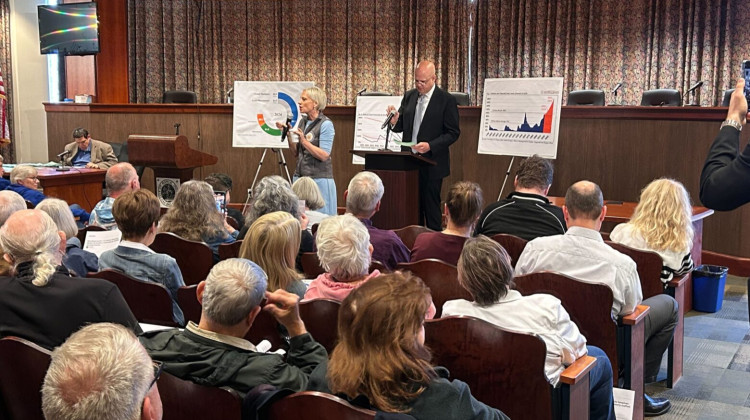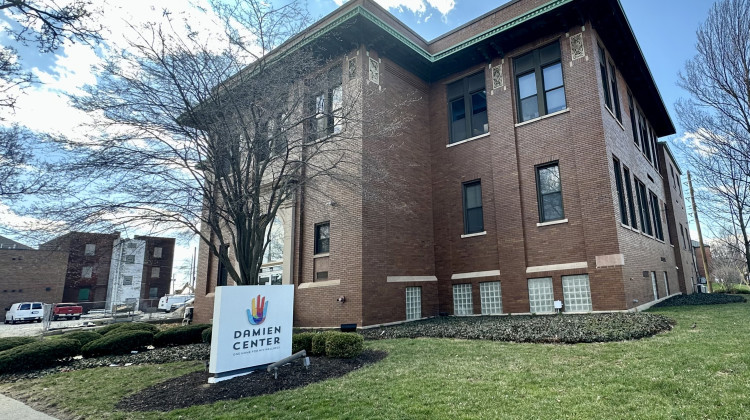Second-generation West Lafayette farmer Kevin Underwood has three tractors he uses to farm 1,600 acres of land – one is several decades old, another he bought just a few years ago. But while his 30-year old tractor still works well, Underwood says the system taxing what that tractor produces does not.
“The bind we’re in at this point is we’ve got income level going down and taxes and input costs continuing to go up,” Underwood said.
He says falling crop prices and a spike in the value of farm land have left him operating too close to his means – and it’s likely to stay that way for several years if the system isn’t changed.
The state uses a complex formula to determine how much each farm pays in taxes. But the numbers used are three-to-four years old, in many cases. That means Underwood’s farm is taxed based on the crops it produced a few years ago, and how much money it reaped from those crops in the past.
But a steep drop in corn and soybean prices means each acre Underwood farms today isn’t making as much profit as it was three years ago, when prices were higher.
Legislators have suggested changing the formula in different ways. Crawfordsville Rep. Tim Brown has written a bill proposing integrating conservation practices into the formula. But even Brown, who heads the House Ways and Means Committee, hasn’t found a way to make up the money that would be lost to local government.
“There’s no alternative source of money in the bill or in any of the bills related to ag taxation, so it would impact local governments and it potentially could affect other rate-payers,” Brown said.
LOOKING FOR ALTERNATIVES
Putnam County Council President Darrel Thomas says he’s not opposed to the idea, but he doesn’t know the best way to enact it.
“We can talk about it, but we don’t know how all to go about doing that and to be fair to everybody,” Thomas said.
He says if tax money from farms is decreased, his county may experience a shortfall that could require drastic action to close.
“We may have to lay off people. Some people have said, ‘Well, let’s even close the courthouse for two or three days a week,’" Thomas said. "So it would be those kinds of things that we would have to do as a county council to offset the potential for a loss.”
Indiana Farm Bureau President Don Villwock says Brown’s bill doesn’t promise a real tax break for farmers. He is one of many to argue the real problem is the four-year lag the formula is based on.
“We’re looking at ways of maybe tweaking that formula, we’re looking at the number of years used in the formula…and I would say when times were good here in the past few years, farmers really didn’t mind paying property taxes so much because their incomes could reflect that,” Villwock said.
Because of the lag, economists are able to predict the base rate for 2018 to be nearly $3,050 per acre. As long as the base rate increases, property taxes increase.
Purdue agricultural economist Larry DeBoer says the lag time could be shortened, but the short-term effect would be a drastic increase in farm taxes.
“If you shorten that lag now, you bring that $3,000 number from 2018 up to 2016," DeBoer said. "In other words, you create an even bigger jump in farmland assessments before you can get to that peak and that decline.”
PROPERTY TAX CAPS
The other facet of the system under examination is the state constitution’s two-percent tax cap for farm property. DeBoer says cutting that percentage would provide direct relief to farmers.
Buck Creek Republican Sen. Brandt Hershman proposes a freeze in the base rate until a permanent solution is created. He wants a legislative study committee to do further research.
Farmer Kevin Underwood endorses Hershman’s idea. He says if taxes increase as projected, many farmers will have to sacrifice quality of work and life.
“If you take even just Purdue’s projections for crop prices versus what we’re seeing in terms of input cost, we’re basically break even, at best, this coming year and when you throw into that mix increased property taxes, it’s really putting most farming operations in the red,” Underwood said.
Back in his barn, Underwood notes the news isn’t all bad – for instance, fuel prices are down in recent months. But he says when he tries to explain how much gas he uses to tend his crops, most people are shocked.
“They were asking, ‘So how often do you have to fill up your combine?’ ‘Oh, about once a day.’ ‘And how many gallons does that take?’ ‘Oh, about 200-250,’ and they just about fell over dead because that’s the kind of dollar amounts you’re dealing with on a regular basis," Underwood said. "Most people don’t even realize that that’s kind of the level that you’re playing with.”
Still, the large amount of money spent on gas is not the big price tag Underwood is worried about. It’s the taxes on the $1.5 million worth of land he owns.
 DONATE
DONATE




 View More Articles
View More Articles

 Support WFYI. We can't do it without you.
Support WFYI. We can't do it without you.